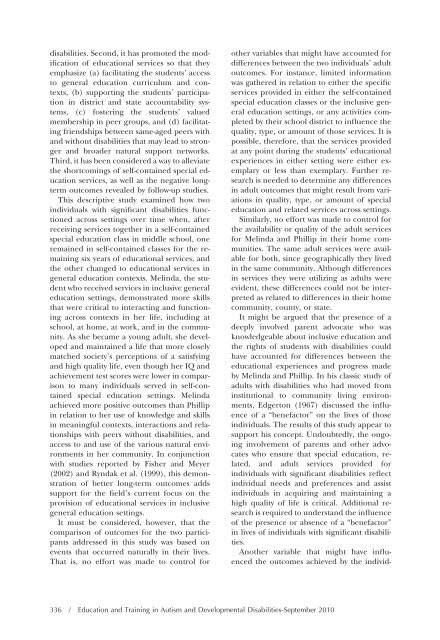Education and Training in Autism and Developmental Disabilities
Education and Training in Autism and Developmental Disabilities
Education and Training in Autism and Developmental Disabilities
You also want an ePaper? Increase the reach of your titles
YUMPU automatically turns print PDFs into web optimized ePapers that Google loves.
disabilities. Second, it has promoted the modification<br />
of educational services so that they<br />
emphasize (a) facilitat<strong>in</strong>g the students’ access<br />
to general education curriculum <strong>and</strong> contexts,<br />
(b) support<strong>in</strong>g the students’ participation<br />
<strong>in</strong> district <strong>and</strong> state accountability systems,<br />
(c) foster<strong>in</strong>g the students’ valued<br />
membership <strong>in</strong> peer groups, <strong>and</strong> (d) facilitat<strong>in</strong>g<br />
friendships between same-aged peers with<br />
<strong>and</strong> without disabilities that may lead to stronger<br />
<strong>and</strong> broader natural support networks.<br />
Third, it has been considered a way to alleviate<br />
the shortcom<strong>in</strong>gs of self-conta<strong>in</strong>ed special education<br />
services, as well as the negative longterm<br />
outcomes revealed by follow-up studies.<br />
This descriptive study exam<strong>in</strong>ed how two<br />
<strong>in</strong>dividuals with significant disabilities functioned<br />
across sett<strong>in</strong>gs over time when, after<br />
receiv<strong>in</strong>g services together <strong>in</strong> a self-conta<strong>in</strong>ed<br />
special education class <strong>in</strong> middle school, one<br />
rema<strong>in</strong>ed <strong>in</strong> self-conta<strong>in</strong>ed classes for the rema<strong>in</strong><strong>in</strong>g<br />
six years of educational services, <strong>and</strong><br />
the other changed to educational services <strong>in</strong><br />
general education contexts. Mel<strong>in</strong>da, the student<br />
who received services <strong>in</strong> <strong>in</strong>clusive general<br />
education sett<strong>in</strong>gs, demonstrated more skills<br />
that were critical to <strong>in</strong>teract<strong>in</strong>g <strong>and</strong> function<strong>in</strong>g<br />
across contexts <strong>in</strong> her life, <strong>in</strong>clud<strong>in</strong>g at<br />
school, at home, at work, <strong>and</strong> <strong>in</strong> the community.<br />
As she became a young adult, she developed<br />
<strong>and</strong> ma<strong>in</strong>ta<strong>in</strong>ed a life that more closely<br />
matched society’s perceptions of a satisfy<strong>in</strong>g<br />
<strong>and</strong> high quality life, even though her IQ <strong>and</strong><br />
achievement test scores were lower <strong>in</strong> comparison<br />
to many <strong>in</strong>dividuals served <strong>in</strong> self-conta<strong>in</strong>ed<br />
special education sett<strong>in</strong>gs. Mel<strong>in</strong>da<br />
achieved more positive outcomes than Phillip<br />
<strong>in</strong> relation to her use of knowledge <strong>and</strong> skills<br />
<strong>in</strong> mean<strong>in</strong>gful contexts, <strong>in</strong>teractions <strong>and</strong> relationships<br />
with peers without disabilities, <strong>and</strong><br />
access to <strong>and</strong> use of the various natural environments<br />
<strong>in</strong> her community. In conjunction<br />
with studies reported by Fisher <strong>and</strong> Meyer<br />
(2002) <strong>and</strong> Ryndak et al. (1999), this demonstration<br />
of better long-term outcomes adds<br />
support for the field’s current focus on the<br />
provision of educational services <strong>in</strong> <strong>in</strong>clusive<br />
general education sett<strong>in</strong>gs.<br />
It must be considered, however, that the<br />
comparison of outcomes for the two participants<br />
addressed <strong>in</strong> this study was based on<br />
events that occurred naturally <strong>in</strong> their lives.<br />
That is, no effort was made to control for<br />
other variables that might have accounted for<br />
differences between the two <strong>in</strong>dividuals’ adult<br />
outcomes. For <strong>in</strong>stance, limited <strong>in</strong>formation<br />
was gathered <strong>in</strong> relation to either the specific<br />
services provided <strong>in</strong> either the self-conta<strong>in</strong>ed<br />
special education classes or the <strong>in</strong>clusive general<br />
education sett<strong>in</strong>gs, or any activities completed<br />
by their school district to <strong>in</strong>fluence the<br />
quality, type, or amount of those services. It is<br />
possible, therefore, that the services provided<br />
at any po<strong>in</strong>t dur<strong>in</strong>g the students’ educational<br />
experiences <strong>in</strong> either sett<strong>in</strong>g were either exemplary<br />
or less than exemplary. Further research<br />
is needed to determ<strong>in</strong>e any differences<br />
<strong>in</strong> adult outcomes that might result from variations<br />
<strong>in</strong> quality, type, or amount of special<br />
education <strong>and</strong> related services across sett<strong>in</strong>gs.<br />
Similarly, no effort was made to control for<br />
the availability or quality of the adult services<br />
for Mel<strong>in</strong>da <strong>and</strong> Phillip <strong>in</strong> their home communities.<br />
The same adult services were available<br />
for both, s<strong>in</strong>ce geographically they lived<br />
<strong>in</strong> the same community. Although differences<br />
<strong>in</strong> services they were utiliz<strong>in</strong>g as adults were<br />
evident, these differences could not be <strong>in</strong>terpreted<br />
as related to differences <strong>in</strong> their home<br />
community, county, or state.<br />
It might be argued that the presence of a<br />
deeply <strong>in</strong>volved parent advocate who was<br />
knowledgeable about <strong>in</strong>clusive education <strong>and</strong><br />
the rights of students with disabilities could<br />
have accounted for differences between the<br />
educational experiences <strong>and</strong> progress made<br />
by Mel<strong>in</strong>da <strong>and</strong> Phillip. In his classic study of<br />
adults with disabilities who had moved from<br />
<strong>in</strong>stitutional to community liv<strong>in</strong>g environments,<br />
Edgerton (1967) discussed the <strong>in</strong>fluence<br />
of a “benefactor” on the lives of those<br />
<strong>in</strong>dividuals. The results of this study appear to<br />
support his concept. Undoubtedly, the ongo<strong>in</strong>g<br />
<strong>in</strong>volvement of parents <strong>and</strong> other advocates<br />
who ensure that special education, related,<br />
<strong>and</strong> adult services provided for<br />
<strong>in</strong>dividuals with significant disabilities reflect<br />
<strong>in</strong>dividual needs <strong>and</strong> preferences <strong>and</strong> assist<br />
<strong>in</strong>dividuals <strong>in</strong> acquir<strong>in</strong>g <strong>and</strong> ma<strong>in</strong>ta<strong>in</strong><strong>in</strong>g a<br />
high quality of life is critical. Additional research<br />
is required to underst<strong>and</strong> the <strong>in</strong>fluence<br />
of the presence or absence of a “benefactor”<br />
<strong>in</strong> lives of <strong>in</strong>dividuals with significant disabilities.<br />
Another variable that might have <strong>in</strong>fluenced<br />
the outcomes achieved by the <strong>in</strong>divid-<br />
336 / <strong>Education</strong> <strong>and</strong> <strong>Tra<strong>in</strong><strong>in</strong>g</strong> <strong>in</strong> <strong>Autism</strong> <strong>and</strong> <strong>Developmental</strong> <strong>Disabilities</strong>-September 2010

















